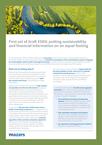
First set of draft ESRS: putting sustainability and financial information on an equal footing
Required by the Corporate Sustainability Reporting Directive (CSRD) and delivered by the European Financial Reporting Advisory Group (EFRAG) to the European Commission (EC), ESRS prescribe both the content and format of sustainability-related information intended to meet users’ needs for high-quality, comparable and relevant information on sustainability issues.
Raising sustainability information on an equal footing with financial information, ESRS specify qualitative and quantitative information to be disclosed, adopting both a retrospective and forward-looking approach. Where appropriate, information disclosed will have to be based on conclusive scientific evidence.
What are the main challenges for companies?
ESRS represent a major shift as they create new demanding transparency obligations on companies’ commitment to sustainability, all the more since the sustainability statements will have to be audited. At inception, limited assurance will be required over compliance with ESRS, with a possible move to reasonable assurance.
As a first step, companies should first assess whether they are within the scope of the CSRD and when they will have to publish sustainability statements under ESRS for the first time.
Challenges in implementing ESRS will depend on whether the company was already subject to Non-Financial Reporting Directive (NFRD) requirements and in which member state the company is established, as the NFRD left significant flexibility to member states to transpose into national law. In all cases, first-time application of Set 1 will necessitate revisiting the materiality assessment considering the entire value chain. Then a thorough analysis of the disclosure requirements and associated data points listed in ESRS will have to be performed in order to identify which material information has to be disclosed to cover material impacts, risks and opportunities identified by the company in relation to sustainability matters.
What are the key features of ESRS?
Under ESRS, sustainability-related information takes a double-materiality approach to the full spectrum of environmental, social and governance (ESG) topics, whereby companies will have to report both on the impacts of their activities on people and the environment, and on how various sustainability matters affect them. While this first draft of ESRS covers all information that is likely to be material regardless of the sector(s) companies operate in, sector-specific standards will subsequently complement these sector-agnostic standards. This represents another major step as most sustainability-related topics are relevant only when taking a sectoral approach. In addition, entity-specific information will also have to be provided, where necessary.
The reporting structure of ESRS is aligned with the Recommendations of the Task Force on Climate-related Financial Disclosures (TCFD). ESRS therefore cover governance, strategy, management of impacts, risks and opportunities, as well as metrics and targets.
In practice, Set 1 includes 12 draft sector-agnostic standards, two cross-cutting standards and ten topical standards, including five on environmental matters, four covering social matters and one on governance.
In drafting ESRS, EFRAG has ensured that its proposals comply with other EU legislation such as the Sustainable Finance Disclosure Regulation (SFDR) regarding the “principal adverse impacts” indicators, or the information required by regulatory technical standards prepared by the European Banking Authority (EBA) regarding Pillar III sector-agnostic disclosures.
Sustainability statements will have to be presented in a clearly identifiable dedicated section of the management report. They will be presented in a digital format using the European Single Electronic Format (ESEF) based on an XBRL taxonomy yet to be prepared.
What’s changed compared to previous drafts?
Considering the feedback received from stakeholders in the course of outreach events and the public consultation which took place earlier this year, EFRAG has streamlined its proposals in order to remove unnecessary complexity and limit the disclosure requirements to sector-agnostic information necessary to meet CSRD objectives. In practice, the number of disclosure requirements and related data points have been significantly reduced, overall leading to less granular information. Cost benefit analyses have also been conducted.
Besides, the materiality approach has been clarified and simplified, notably the much criticised “rebuttable presumption” has been removed, with some specific information being mandatory in all cases and not subject to the materiality approach. This notably concerns ESRS 2 on general requirements, ESRS E1 on climate change and sustainability information required by other EU legislation such as SFDR or Pillar III disclosures.
Regarding due diligence, Set 1 proposes stronger alignment with international guidelines without pre-empting the content of the future Corporate Sustainability Due Diligence Directive (CSDDD) the draft text of which was released in February 2022.
Last but not least, and as requested by CSRD, Set 1 has been further aligned with international initiatives in order to promote interoperability with global standard-setting initiatives to the greatest extent possible, notably that of the International Sustainability Standards Board (ISSB). IFRS S1 on general requirements and IFRS S2 on climate-related disclosures are expected to be published as early as possible in 2023. The draft ESRS also incorporate to the greatest extent possible the content of the Global Reporting Initiative (GRI) standards.
When will the CSRD apply to your organization?
Reporting year | Publication | Who |
2024 | 2025 | Large and listed companies falling under NFRD |
2025 | 2026 | Large and listed companies NOT falling under NFRD |
2026 | 2027 | Listed SMEs (published over 2025) - 2 year grace period |
2028 | 2029 | Non-EU companies with branches/subsidiaries |
October 2026 | Limited assurance standard | |
October 2028 | Reasonable assurance standard |
Next steps
The EC will adopt Set 1 by 30 June 2023 by way of delegated acts, (meaning no transposition into national law is needed), which will then be followed by a scrutiny period by the European Parliament and Council. Prior to this, the EC will consult various groups, committees and agencies, including the European Securities and Markets Authority (ESMA), to ensure that ESRS take account of the views of the member states and that they are consistent with relevant EU policy and legislation. As a result, further changes to the standards may happen.
By 30 June 2023, the European sustainability reporting framework will be subsequently complemented by sector-specific standards that will be mandatory to all large companies, initially covering ten sectors, with the remaining 31 sectors covered over the next two years. In addition, standards for listed small and medium-sized enterprises (SMEs), non-EU company standards and voluntary guidance for unlisted SMEs will also be issued.
In terms of transitional provisions, a company applying ESRS for the first time may defer the presentation of comparative information by one year. Plus, a phased-in approach has been decided on less mature topics, in particular with a three-year relief for information regarding the value chain and disclosures on potential financial effects of material environmental-related risks and opportunities.
As we look ahead to the future, ESRS are set to provide a robust basis for reporting sustainability information. In the meantime, companies should prepare as soon as possible in order to comply with the new requirements and make it a strategic lever for sustainability and business performance.




